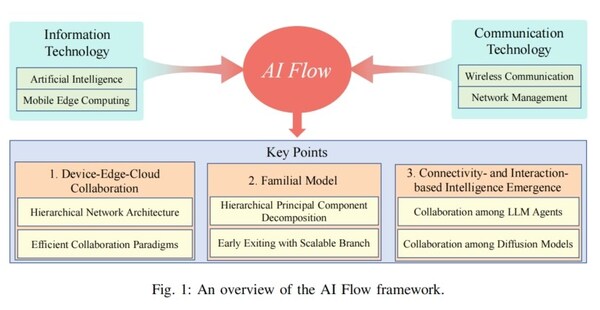SHANGHAI, July 11, 2025 /PRNewswire/ — AI Flow, the innovative framework developed by TeleAI, the Institute of Artificial Intelligence of China Telecom, has been recognized as a key role in the intelligent transformation of telecom infrastructure and services in the latest report by Omdia, a premier technology research and advisory firm. The report highlights AI Flow’s exceptional capabilities in addressing the edge GenAI implementation challenges, showcasing its device-edge-cloud computing architecture that optimizes both performance and efficiency as well as its groundbreaking combination of information and communication technologies.
According to the report, AI Flow facilitates seamless intelligence flow, allowing device-level agents to overcome the limitations of a single device and achieve enhanced functionality. The same communication network can connect advanced LLMs, VLMs, and diffusion models across heterogeneous nodes. By facilitating real-time, synergistic integration and dynamic interaction among these models, the approach achieves emergent intelligence that exceeds the capabilities of any individual model.
Lian Jye Su, Chief Analyst at Omdia, remarked that AI Flow has demonstrated sophisticated approaches to facilitate efficient collaboration across device-edge-cloud tiers and to achieve emergent intelligence through connective and interactive model operations.
The unveiling of AI Flow has also drawn great attention from the AI community on global social media. AI industry observer EyeingAI said on X “It’s a grounded, realistic take on where AI could be headed. ” AI tech influencer Parul Gautam said on X that AI Flow is pushing AI boundaries and ready to shape the future of intelligent connectivity.
Fulfill the Vision of Ubiquitous Intelligence in Future Communication Networks
AI Flow, under the leadership of Professer Xuelong Li, the CTO and Chief Scientist of China Telecom and Director of TeleAI, is introduced to address the significant challenges of the deployment of emerging AI applications posed by hardware resource limitations and communication network constraints, enhancing the scalability, responsiveness, and sustainability of real world AI systems. It is a multidisciplinary framework designed to enable seamless transmission and emergence of intelligence across hierarchical network architectures by leveraging inter-agent connections and human-agent interactions. At its core, AI Flow emphasizes three key points:
Device-Edge-Cloud Collaboration: AI Flow leverages a unified device-edge-cloud architecture, integrating end devices, edge servers, and cloud clusters, to dynamically optimize scalability and enable low-latency inference of AI models. By developing efficient collaboration paradigms tailored for the hierarchical network architecture, the system minimizes communication bottlenecks and streamlines inference execution.
Familial Models: Familial models refer to a set of multi-scale architectures designed to address diverse tasks and resource constraints within the AI Flow framework. These models facilitate seamless knowledge transfer and collaborative intelligence across the system through their interconnected capabilities. Notably, the familial models are feature-aligned, which allows efficient information sharing without the need for additional middleware. Furthermore, through well-structured collaborative design, deploying familial models over the hierarchical network can achieve enhanced inference efficiency under constrained communication bandwidth and computational resources.
Connectivity- and Interaction-based Intelligence Emergence: AI Flow introduces a paradigm shift to facilitate collaborations among advanced AI models, e.g., LLMs, vision-language models (VLMs), and diffusion models, thereby stimulating emergent intelligence surpassing the capability of any single model. In this framework, the synergistic integration of efficient collaboration and dynamic interaction among models becomes a key boost to the capabilities of AI models.
See AI Flow’s tech articles here:
https://www.arxiv.org/abs/2506.12479
https://ieeexplore.ieee.org/document/10884554
AI Flow’s First Move: AI-Flow-Ruyi Familial Model
Notably, TeleAI has just open-sourced the first version of AI Flow’s familial model: AI-Flow-Ruyi-7B-Preview last week on GitHhub.
The model is designed for the next-generation device-edge-cloud model service architecture. Its core innovation lies in the shared intermediate features across models of varying scales, enabling the system to generate response with a subset of parameters based on problem complexity through an early-exit mechanism. Each branch can operate independently while leveraging their shared stem network for computation reduction and seamless switching. Combined with distributed device-edge-cloud deployment, it achieves collaborative inference among large and small models within the family, enhancing the efficiency of distributed model inference.
Open-source address:
https://github.com/TeleAI-AI-Flow/AI-Flow-Ruyi
About TeleAI
TeleAI, the Institute of Artificial Intelligence of China Telecom, is a pioneering team of AI scientists and enthusiasts, working to create breakthrough AI technologies that could build up the next generation of ubiquitous intelligence and improve people’s wellbeing. Under the leadership of Professor Xuelong Li, the CTO and Chief Scientist of China Telecom, TeleAI aims to continuously expand the limits of human cognition and activities, by expediting research on AI governance, AI Flow, Intelligent Optoelectronics (with an emphasis on embodied AI), and AI Agents.
For more information:
https://www.teleai.com.cn/product/AboutTeleAI



